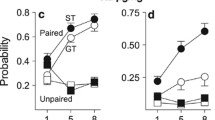Abstract
The effectiveness of temporal and environmental cues in eliciting conditioned hypothermia and hyperthermia was studied in male Wistar rats using as an unconditioned stimulus an IP injection of 20 mg/kg of morphine sulfate. The relevance of temporal stimuli was minimized in Experiment 1 by administering morphine at irregular times on alternate days. For one group (Cond) morphine injections were preceded and followed by periods in distinctive environments. Group Pseudo animals, though exposed to the environments, received morphine on the intervening days in the home cage; group Saline received only saline. All animals receiving morphine showed a non-specific hypothermia when not under the direct influence of morphine. A “conditioned hyperthermia” was evident in group Cond animals in the distinctive environments. In Experiment 2, in which animals remained in their home cages at all times, the releavance of temporal cues was emphasized by administering morphine at exactly 24 h intervals. These animals became hypothermic only around the time of the expected injection. Animals in another group that received morphine at irregular times showed the non-specific hypothermia seen previously. There was no evidence for a conditioned hyperthermia in this second experiment.
Similar content being viewed by others
References
Ary M, Lomax P (1979) Influence of narcotic agents on temperature regulation. In: Loh HH, Ross DH (eds) Neurochemical mechanisms of opiates and endorphins. Raven, New York, p 429
Chodera A (1966) The influence of Marsilid on the temperature response in rats after morphine. Arch Int Pharmacodyn Ther 144:362–369
Clark WG (1979) Influence of opioids on central thermoregulatory mechanisms. Pharmacol Biochem Behav 10:609–613
Drawbaugh R, Lal H (1974) Reversal by narcotic antagonist of a narcotic action elicited by a conditional stimulus. Nature 247:65–67
Drawbaugh R, Lal H (1976) Effect of pharmacological interference with various neuropathways on blockade of morphine-withdrawal hypothermia by morphine and by conditional stimulus. Neuropharmacology 15:375–378
Eikelboom R, Stewart J (1979) Conditioned temperature effects using morphine as the unconditioned stimulus. Psychopharmacology 61:31–38
Frumkin K (1976) Differential potency of taste and audiovisual stimuli in the conditioning of morphine withdrawal in rats. Psychopharmacologia 46:245–248
Gunne LM (1960) The temperature response in rats during acute and chronic morphine administration a study of morphine tolerance. Arch Int Pharmacodyn Ther 129:416–428
Lal H, Miksic S, Drawbaugh R (1978) Influence of environmental stimuli associated with narcotic administration on narcotic actions and dependence. In: Adler ML, Manara L, Samanin R (eds) Factors affecting the action of narcotics. Raven, New York, p 643
Lal H, Miksic S, Smith N (1976) Naloxone antagonism of conditioned hyperthermia: An evidence for release of endogenous opioid. Life Sci 18:971–976
Lomax P (1966) Measurement of ‘core’ temperature in the rat. Nature 210:854–855
Martin GE, Pryzbylik AT, Spector NH (1977) Restraint alters the effects of morphine and heroin on core temperature in the rat. Pharmacol Biochem Behav 7:463–469
Martin WR, Wikler A, Eades CG, Pescor FT (1963) Tolerance to and physical dependence on morphine in rats. Psychopharmacologia 4:247–260
Maynert EW, Klingman GI (1962) Tolerance to morphine. Effects on catecholamines in the brain and adrenal glands. J Pharmacol Exp Ther 135:285–295
Miksic S, Smith N, Numan R, Lal H (1975) Acquisition and extinction of a conditioned hyperthermic response to a tone paired with morphine administration. Neuropsychobiology 1:277–283
Mucha RF, Kalant H, Linseman MA (1979) Quantitative relationships among measures of morphine tolerance and physical dependence in the rat. Pharmacol Biochem Behav 10:397–405
Oka T, Nozaki M (1970) The effects of parachlorophenylalanine on nontolerant rats and of cholinergic blocking drugs on tolerant rats to morphine. Jpn J Pharmacol 20:455–457
Oka T, Nozaki M, Hosoya E (1972) Effects of p-chlorophenylalanine and cholinergic antagonists on body temperature changes induced by administration of morphine to nontolerant and morphine-tolerant rats. J Pharmacol Exp Ther 180:136–143
Roffman M, Reddy C, Lal H (1973) Control of morphine-withdrawal hypothermia by conditioned stimuli. Psychopharmacologia 29:197–201
Rosenfeld GC, Burks TF (1977) Single-dose tolerance to morphine hypothermia in the rat: differentiation of acute from long-term tolerance. J Pharmacol Exp Ther 202:654–659
Rudy TA, Yaksh TL (1977) Hyperthermic effects of morphine: set point manipulation by a direct spinal action. Br J Pharmacol 61:91–96
Sherman JE (1979) The effects of conditioning and novelty on the rat's analgesic and pyretic responses to morphine. Learning and Motivation 10:383–418
Siegel S (1978) Tolerance to the hyperthermic effect of morphine in the rat is a learned response. J Comp Physiol Psychol 92:1137–1149
Stewart J, Eikelboom R (1978) Pre-exposure to morphine and the attenuation of conditioned taste aversion in rats. Pharmacol Biochem Behav 9:639–645
Thornhill JA, Hirst M, Gowdey CW (1978) Changes in the hyperthermic responses of rats to daily injections of morphine and the antagonism of the acute response by naloxone. Can J Physiol Pharmacol 56:483–489
White N, Sklar L, Amit Z (1977) The reinforcing action of morphine and its paradoxical side effect. Psychopharmacology 52:63–66
Wikler A, Pescor FT (1967) Classical conditioning of a morphine abstinence phenomenon, reinforcement of opioid-drinking behavior and ‘relapse’ in morphine-addicted rats. Psychopharmacologia 10:255–284
Wise RA, Yokel RA, deWit H (1976) Both positive reinforcement and conditioned aversion from amphetamine and from apomorphine in rats. Science 191:1273–1275
Author information
Authors and Affiliations
Rights and permissions
About this article
Cite this article
Eikelboom, R., Stewart, J. Temporal and environmental cues in conditioned hypothermia and hyperthermia associated with morphine. Psychopharmacology 72, 147–153 (1981). https://doi.org/10.1007/BF00431648
Received:
Accepted:
Issue Date:
DOI: https://doi.org/10.1007/BF00431648




